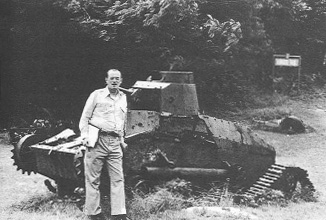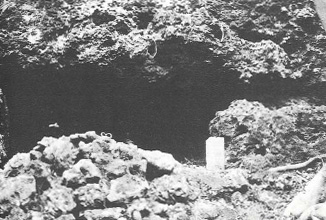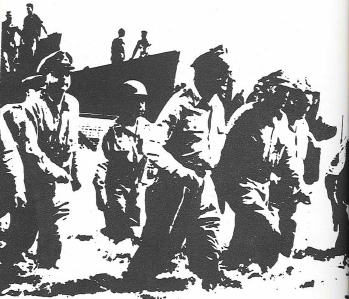Goodbye, Darkness (43 page)

Ricky Bordallo thinks there are more stragglers out there. He predicts they will come in from the hot in 1994, the fiftieth anniversary of the battle. If so, their artifacts, like Yokoi's, will be preserved in Guam's museum, whose most enthusiastic patroness is Ricky's Minnesota-born wife, Madeleine. The museum is an archaeologist's paradise: prehistoric mortars and pestles; ancient pottery shards fashioned from the island's thick red clay; a
belembautuyan
, which is a stringed instrument startlingly like those found in the interior of Brazil; huge stone
rai
disks, some of them twelve feet in diameter, once used for money on the Yap Islands, which lie five hundred miles to the southwest — the
rai
have holes in the center to permit them to be strung on poles and carried on men's shoulders — and blubber pots brought in 1823 by British whalers. Outside the museum is the Kiosko, or “Chocolate House,” a gazebo where upper-class Chamorro women once gathered each afternoon to eat sweets and gossip. Nearby a handsome young priest, Thomas Devine, has rebuilt a primitive Guamanian village, an exact replica of those found by the first Spaniards four and a half centuries ago. It is seductive; my New England drive flags; I find my mind drifting, wondering what it would be like to be a beach comber, wondering, like Captain Cook, whether Magellan's arrival has been good for the Guamanians or bad for the Guamanians.

The author with the relic of an enemy tank

A cave with Japanese gun emplacement
Guam's architecture, like its history, reflects a hodgepodge of influences: Spanish, English, Chinese, German, Filipino, and Dutch. But the prevailing influence is American. Mustard-colored stucco walls are flimsy carbons of Beverly Hills originals. Orote's airfield has been cleared of bamboo clumps which sprang up after the war and is now used by local teenagers as a drag strip. The outskirts of Agana, which has never really recovered from its wartime devastation — 90 percent of its prewar population never returned; it looks like a ghost town — are cultural atrocities: junk-food stands, supermarkets, bars, filling stations, discount houses. Partly because taxi fares are exorbitant, there are over forty thousand Detroit gas-guzzlers on the island. Unless you are lucky enough to have a friend who will put you up, you stay at the Guam Hilton Hotel on Tumon Bay.
Looking up from the hotel pool you can see Nimitz Hill, the admiral's headquarters in the final months of the war and still a treasured property of the U.S. Navy. One source of abrasion, were the islanders less complaisant, would be this huge U.S. military presence on the island. Erwin Canham, whose siesta I interrupted on Saipan, confirmed their tolerance of it. The Canhams chose to live in the Marianas after he had retired as editor of the
Christian Science Monitor.
Over and over they express astonishment that the Saipanese and the Guamanians, who have much to be bitter about, are unresentful, though clearly they were pawns in a titanic quarrel, victims because they happened to be bystanders. Guamanians have erected war memorials for their sons lost in battle, and not just in the battle of 1944. They cannot participate in American presidential elections. Their representative in Congress can vote in committee but not on the floor. They couldn't even choose their own governor until 1970. Yet islanders of military age were drafted and sent to Vietnam.
Guam was a major staging area in that hopeless war; over 100,000 U.S. GIs passed through here. Since Okinawa was returned to Japanese rule in 1972, Guam has become the chief U.S. base in the western Pacific. Nearly 20,000 uniformed Americans are stationed on the island, and it is the home of a B-52 fleet. The navy owns a third of the isle — all of it prime real estate, with vast tracts where officers hunt wildlife and where one finds lovely beaches for wives and children. The navy opposes first-class citizenship for the islanders because they still read, speak, pray, and are taught Chamorro. The Guamanians reply that linguistic differences haven't crippled Puerto Ricans, that the Viet Cong didn't spare them because they hadn't mastered the English. In the islanders' opinion, the admirals regard Guam as the navy's paradise and intend to keep it as such.
Yet all this is low-key. Guamanians are proud of their relationship with the United States. They have built an unknown soldier a memorial: “Here lies in honored glory an American soldier known but to God.” The length of shoreline where our Orote force came ashore is called Invasion Beach; the coast below Chonito Cliff is Nimitz Beach. On the first, near two rusting Jap warships, are gazebos for family picnics; an elementary school has been built near the second, and a spent artillery shell is cemented there into a stone marker. Every July 21 the island celebrates “Liberation Day,” in remembrance of the Marines and GIs who retook Guam. Schools are out, shops are closed, and community leaders deliver eloquent patriotic speeches pitched on an emotional level unheard in the United States for at least a generation. American visitors find them embarrassing, which perhaps says more about them than about the rhetoricians. Veterans' Day is similarly observed. On a cloudless November 11 I found myself in a packed square, sitting in the front row with Ricky, a U.S. general, and two flag officers of the navy. Toward the end of the ceremony the band played a medley of U.S. military songs. There is a tradition that anyone who has served in the Marine Corps must stand when he hears the “Marines' Hymn.” I hadn't been in that situation since my return to civilian life, but I was in it now. Somewhat to my amazement — for I am not that kind of man, and I scorn the sequins of militarism — I found myself rising and standing there, the only spectator on his feet, until the band switched to another tune. As the program ended and the crowd broke up, I was surrounded by islanders who wanted to embrace me. It was embarrassing, but it was moving, too. I still don't understand why I did it. But I'm not apologizing.
My last evening on Guam is spent with Ricky and Madeleine atop Oksu Jujan, Chamorro for the heights upon which the governor's mansion stands. Lights play upon a lovely fountain, through the mists of which lighted buildings below us gleam and winkle. Ricky's defeat at the polls overshadows my thoughts. Eviction from high office is always hard, but especially so for the imperious, and Ricky is very much the aristocrat. Yet he is philosophical about his discomfiture. He has lost, he says, but the people haven't; the people never lose a free election. And Guam's devotion to democracy lies as deep as in any of the United States. A clock booms deep within the mansion, and we head for the hay. Checking my watch — I keep zigzagging from one time zone to another — I remember one official here pointing out to me shortly after my arrival that because of the International Date Line, Guam's dawn arrives when it is still early afternoon of the day before in mainland America. Indeed, the local newspaper here carries a front-page ear: “Guam: where America's day begins.” It sounds like one of those old FitzGerald Traveltalks, but it is literally true. The first rays of each sunrise first touch the Stars and Stripes here. It's not a bad start for a day.

I Will Lay Me Down for to Bleed a While …
T
he palau islands, about halfway between the marianas
and the Philippines, are so remote that none of the European colonial powers had bothered to develop them. Indeed, except for a party of sixteenth-century conquistadores led by Ruy López de Villalobos, few outsiders were even aware of the mini-archipelago until the autumn of 1944. Peleliu is the southernmost isle in the Palau group. Roughly speaking, it was to the Palaus what Betio was to Tarawa — the key to the Japanese defense of the surrounding atolls and volcanic land masses. Today it is the least accessible of the central Pacific's great battlefields, hidden away in the trackless deep like a guilty secret. And that is altogether appropriate. It was a bad battle, fought at a bad place and a bad time, with an enemy garrison that could have been left to wither on the vine without altering the course of the Pacific war in any way.
To grasp what happened on Peleliu, or what ought not to have happened, you need only glance at a map of the Pacific. America's two enormous pincers — the drives of MacArthur and Nimitz — were swiftly approaching one another. In the Pentagon, Peleliu seemed necessary to protect MacArthur's flank when he invaded Mindanao, the big island at the bottom of the Philippines. But then Halsey, cruising off the Philippines, launching carrier strikes at Japanese bases, concluded that Leyte, farther up the Filipino island chain, was held by far fewer enemy troops than had been thought. He radioed Nimitz, suggesting the canceling of all other operations, especially Peleliu, which, he had already predicted, would become another Tarawa. In their place he urged the swift seizure of Leyte.
Nimitz relayed the proposal, accompanied by recommendations of his own, to Quebec, where the Combined Chiefs of Staff were attending a formal dinner as guests of Prime Minister W. L. Mackenzie King. Admirals King and Leahy and Generals Marshall and Arnold excused themselves, read the message, and told a staff officer to cable their approval. There was one small difficulty. In Nimitz's endorsement of Halsey's message he insisted that the convoy of Marines steaming toward the Palaus, which was two sailing days from its objective, steam on and take Peleliu anyway. This defies understanding. The island's only strategic value was that it lay 550 miles east of Mindanao, which, under the new plan, would be bypassed.
Part of the problem lay in U.S. ignorance of the Palaus and the assumption that Peleliu would be easy to take. There were no coast-watchers and therefore no information on what was happening there. Intelligence came from navy frogmen demolishing beach obstacles, submarine shore parties, and aerial photographs. Since the frogmen and the submariners could not see inland, they could not contradict the conclusions of those who had analyzed the aerial photographs and said Peleliu was flat. None of them suspected the presence of jagged limestone ridges overlooking the island's airfield, heights which had been turned into fortresses of underground strongpoints shielded by cement, sand, and coral, all connected by tunnels and virtually impervious to air and naval bombardment. One hulk of rock, later to be christened “The Point” by the Marines who had to take it, rose thirty feet above the water's edge, a bastion of huge fractured boulders, deep gorges, and razor-sharp spikes, the entire mass studded with pillboxes reinforced with steel and concrete. It was Tarawa, Saipan, and Guam in spades.
During the preinvasion bombardment, a gunnery officer on the heavy cruiser
Portland
glimpsed what lay ahead. Focusing his field glasses on a Peleliu slope, he saw a coastal gun emerge from a coral fissure. Shells were rapidly fired at the U.S. warships and then the gun was dragged back out of sight. The gunnery officer ordered his crews to hit the coral with five salvos of eight-inch shells. It was done. The gun, untouched, repeated its act. Frustrated, he said, “You can put all the steel in Pittsburgh onto that thing and still not get it.” But he was a junior officer, and in a minority. Admiral Jesse Oldendorf ordered his batteries to cease firing. He said he had run out of targets; the Jap defense had been annihilated. William Rupertus, the Marine commander, told his officers: “We're going to have some casualties, but let me assure you this is going to be a short one, a quickie. Rough but fast. We'll be through in three days. It might take only two.” Company K of the First Marines climbed down the cargo nets singing, “Give my regards to Broadway.” The captain of a transport asked the First Marines' CO, Chesty Puller, “Coming back for supper?” Chesty asked, “Why?” The captain said, “Everything's done over there. You'll walk in.” Puller said, “If you think it's that easy, why don't you come on the beach at five o'clock, have supper with me, and pick up a few souvenirs?”
